Your trekking shoe are your best friend in a trek. It helps you walk safely, comfortably and confidently on a difficult terrain, protects you from the cold, keeps your feet dry and identifies you as a trekker in the mountains. Its one of the most important thing to think for and plan for before heading to your trek in the Himalayas. If your shoe betrays you on your trek, its a waste of all the physical effort you put behind the trek, a heart breaker. So be sure of your trekking shoes..
Understanding your shoe is very important and hence let me first talk about few of the most important and needed features you would look for in your trekking shoe before considering buying it.
What to look for in your trekking shoe before buying ?
Weight of your shoe: You would want your shoe to be light without compromising on the grip and support. Since you wont be carrying your shoe but wearing it, you can do with slightly heavy shoe unless you feel that the weight of the shoe will degrade your walking capacity on the trek. If you are expecting to carry a heavy load on your back while trekking, which you would ideally do, light shoes are not likely for you. In that case, you will need a high ankle trekking shoe ( generally called trekking boot ) with a good sole, and strong ankle and heel support. These kind of shoe are bit heavier but are ideally designed for treks in a rough terrain and lasts longer. A shoe gets heavier for the materials used to make it.
Ankle Protection: Ankle protection is must in the rough terrain of the Himalayas. Market terminologies uses words like Low Cut, Mid Cut and High Cut to name the varieties available. Low cut shoe does not provide sufficient ankle support considering the rough Himalayan terrain in a multiday trek. Hence I am not discussing it. You can probably use it for day hikes on a flat terrain but not the mountains and definitely not the Himalayas.
Ankle support is a very important safety feature. You do not want to return from a trek due to a painful twisted ankle. If your trek is a remote one, imagine walking back to safety with a twisted ankle or the pain that others will take to bring you back to a safe and comfortable zone. If you are carrying weight on your back, added stress comes on your feet which makes you more likely to slip, skid, fall and twisting your ankle. In such situation, ankle and heel support becomes the most important feature on your shoe, as it adds support to your feet and prevents you from slipping and restricts uncontrolled sideward heel movement inside your shoe. Ankle protection not only protects against a twist but also against snow from entering your shoes easily. Gaiters work better on a high ankle shoe.
A better ankle protection should properly cover your ankle and provide support from heel up so that it restricts uncontrolled sideward feet movement inside your shoe. Mid cut and High Cut trekking shoes are the ones to talk about as they provide better support. High cut provides the maximum support and is ideal for a multiday trek. Mid cut too provides good support and can be considered depending on the terrain of your trek and the weight you will be carrying on your back.
Some trekkers do not feel comfortable in ankle protected shoe, but its just about getting used to. Safety is much more important criteria to bank for when compared to comfort.
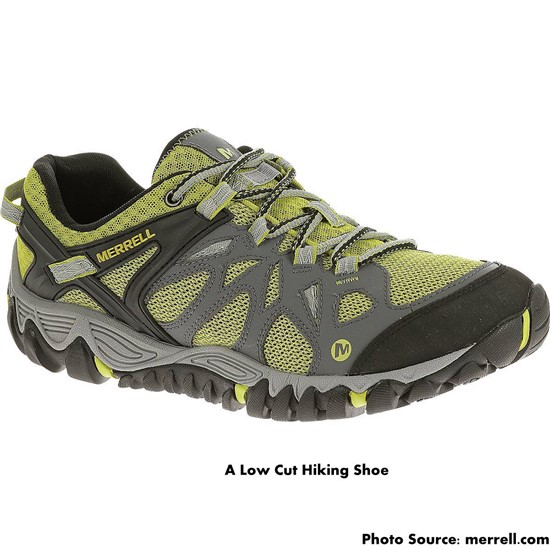
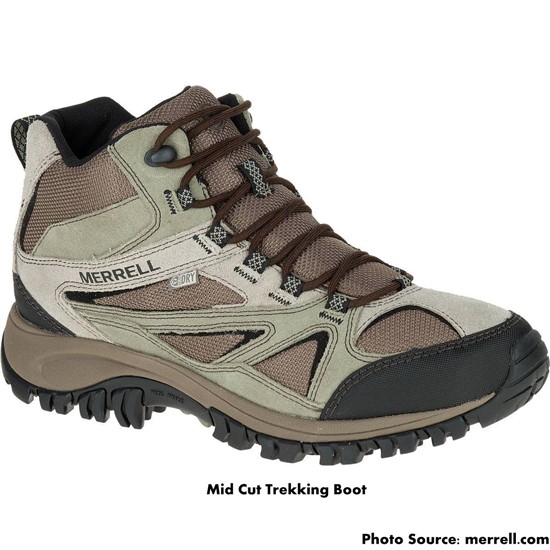

Cushioning and Padding: You would want your shoe to be comfortable and well padded. Each day you will be walking with it on rough terrains, with weight, for an average time of 5 - 6 hours. Further, if you are not carrying an extra camping shoe or a slip on slipper, you will have to be in your shoe for prolonged period of time. Considering these factors, you need a well padded shoe. A good padding will protect your heel, ankle foot base and make you forget about your shoe while trekking. Some brands use air cushioning to better protect your heels. A painful heel is a common problem and a trekker complains of it after couple of days into the trek. So a better cushioning for your heel and a proper walking technique helps keeping this problem away.
Insulation: Trekking usually involves venturing to the high altitude zones of the Himalayas which are snow bound and cold. Although you can increase the insulation by layering your socks but too many socks can make you uncomfortable and make your shoe feel tighter. Therefore, you would want your shoe also to provide some kind of insulation from the cold. Waterproofing ( discussed separately ) is a very important feature here. Different brands have different insulation technology.
Front Or Extended Side Rubber Protection: The front tip of your shoe is very vulnerable to bruises and wears out quickly. While climbing steep in snow, you use toe walking technique and it puts a lot of stress on that part of the shoe. Good trekking shoes provide a rubber shield to protect your shoes in front. This shield also insulates your toe in cold conditions. Its a must feature if you are trekking in snow zone. Some shoes have extended rubber protection which further adds to the protection. Side stepping is a very important technique required to traverse a snow slope. A rubber protection there protects the shoe and provided insulation.
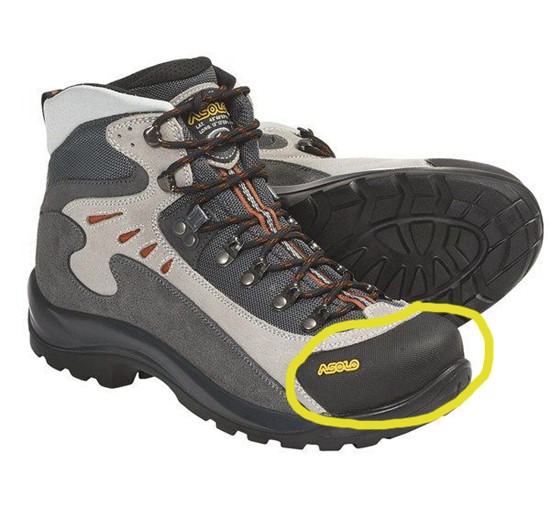

Strength of Stitches: This is a self explanatory but an important feature to look for. With branded shoes, you can stay unworried on this. However, make sure that no stitches are present in the friction prone sections of the shoe as it may tear the stitches and damage your shoe rather quickly.
Size And Fit: In a trek, you should feel comfortable in your shoes. The size and fit plays an important role here. It also help keep blisters away. Its for this reason I prefer buying shoes only after testing it in a store. Sometimes we find a cheaper deal online. In those situation, I suggest knowing your size properly for that brand from your nearest store and then ordering it online, unless its a known shoe for you.While testing your shoe, keep in mind that you will be sometimes using 2 layers of woolen socks to protect from cold. Few may wear even more. Your shoes should have that extra space for it. Its not at all a bad idea to carry 2 woolen socks to the store and try your shoes after wearing those. Also, make sure you keep some space for toe movement. Toe movement will not only keep you away from frost bite, but the air in the space will provide insulation as well to keep your feet warm. The extra space in toe will also protect from hurting your toe while descending. Generally it is advised to buy a size larger to accommodate space for socks and toe space. Hit the toe on the floor to check the impact on the toe, or if the store has a declined plane, test the toe fit by descending on it.
Give equal importance to heel support and comfort while judging the fit of a shoe. This is irrespective of size and is a design feature. Raised heels provide proper resistance and acts as a brake, very important when you are carrying load. A needed feature when trekking with weight on your back. Raised heels also provide comfort. Arched midsole is to look for and different brand has different design. The arch of the midsole should feel comfortable to you and it varies with individual.Your heel should be firm inside a tied shoe. Walk up an inclined plane to test the fit. A shock absorber beneath your heel is very desirable feature.
Check that the insole provides good cushion to your feet from bottom on top of the midsole.
Out Sole - Lug Pattern and Grip On Terrain: Its all about the traction on the terrain that makes things easier for you on the trek. The quality of the sole guarantees that. Mostly the soles are rubber made with different patterns of deep indentations to provide traction and are called the lug-pattern. Deeper the indentations, better the stability. One important feature I check in my sole is the flexibility by bending it at various degrees and angles. I also give importance to a softer sole which means more durability and lesser jerk. Vibram Soles are the most preferred ones in the mountains.

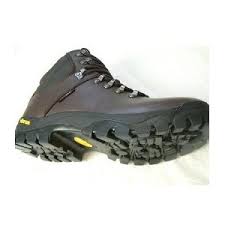

Water Proofing and Breatheability: I somehow feel that the importance of this feature is very much desired and self explanatory for a multiday, high altitude Himalayan trek. However, I do get enquiries if it is at all required or not, may be because it comes for a bit extra cost, and a trekker wants to be sure before investing that extra money on it.
A Himalayan trek takes you up to a remote region where the weather is very volatile. It can rain or snow at anytime. River crossings are also important factor where there is a chance your socks and feet might get wet. If you are to spend few days in snow, a waterproof shoe becomes your most prized possession. A wet shoe also means wet socks which might not dry for days to come. Your shoes, if wet will again take time to dry unless you are lucky to get a bright sunny day. Else, you will start drying your shoes over fire which will not only waste precious resource but also damage your shoe. A wet feet is very dangerous as you risk cold injuries due to it.
Waterproofing is expensive because waterproofing needs breatheability, else your feet will sweat a lot and will be prone to infections and discomfort. Different brands use different technologies for waterproofing. Novadry and Gore Tex are to mention few.
Crampon Fitable: Some of your treks might require you to use a crampons. Trekking crampons are required to grip on hard or packed snow which crossing a pass or attempting a trek summit. Some crampons need grooves to fit perfectly. These are the crampons which are strong and ideal to be used on a steep slope. Some shoes have those grooves. Some crampons can be tied around and does not require a groove to fit a crampon.
Other simple anti slip crampons made of durable rubber are also used to trek over packed snow. These does not require a special groove in the shoe and can be worn over it easily. These anti slips are not made for hard snow.

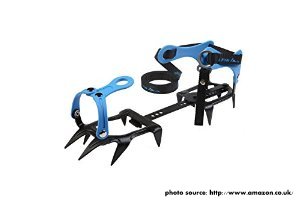
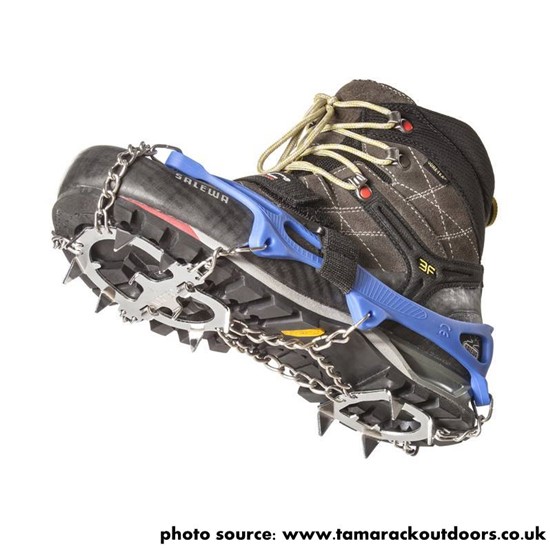
Gaiter Groove: Gaiter groove is important and is a small groove between the heel and toe sections of your sole. When the straps of gaiters are wrapped around it, the groove prevents the strap being cut due to friction between the shoe and ground.
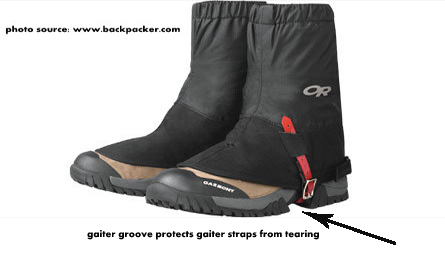
Know Your Trekking Shoe
Before you buy or search for your shoe, it helps knowing your shoe and its various parts. While these parts are generic, each brand will have its own technology to further better it.
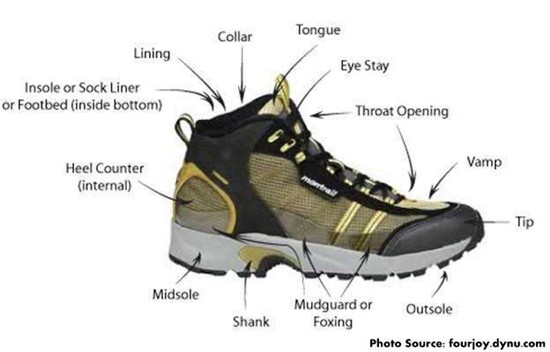 ?
?
Few Popular Brands Found In India and Where To Buy Them
Now you know what to look for in a shoe according to your choice of the treks and how to judge and select them. Few good brands to go for are Forclaz, Salomon, Merrell, Asolo, Geds, La Sportiva, and many more.
Disclaimers:
- Products and links are just an aid and there is not commercial intent behind those
- Its completely the authors opinion as per his experience of the field.